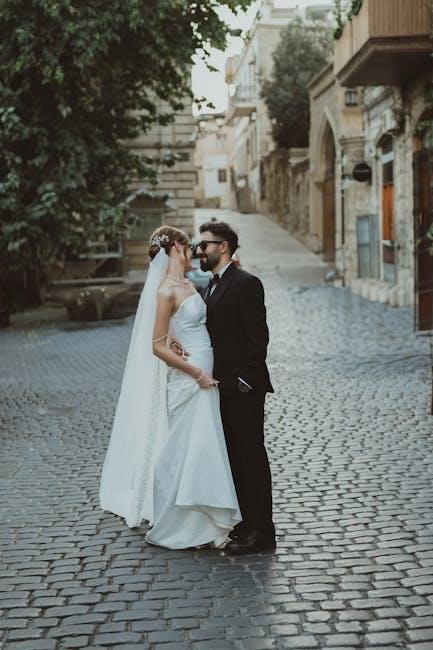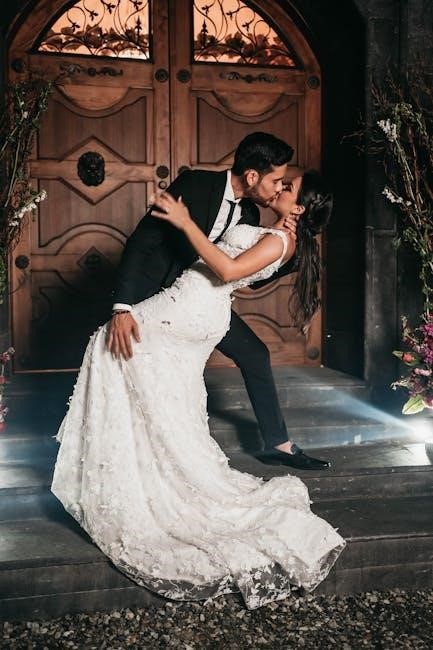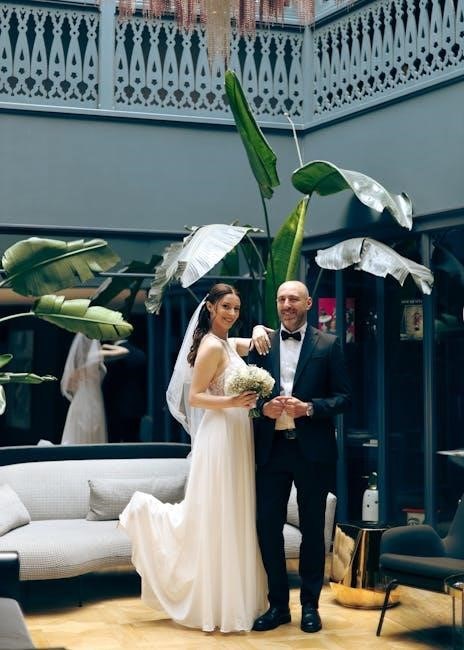
tuxedo size guide
A proper tuxedo fit is essential for both style and comfort. Tuxedo size charts guide individuals through measurements like chest, waist, and inseam to ensure accuracy. Understanding numerical and alphabetical sizing systems (S, R, L) helps in selecting the ideal fit for various body types and preferences. This section introduces the fundamentals of tuxedo sizing, emphasizing the importance of accurate measurements and the role of size charts in achieving a flawless look.
1.1 Understanding the Importance of Proper Fit
A proper fit is crucial for both style and comfort. A tuxedo that is too tight or too loose can ruin the overall aesthetic. Ensuring the jacket, pants, and accessories fit well enhances confidence and creates a polished, elegant appearance. Ill-fitting tuxedos can cause discomfort and distract from the sophistication of the outfit, making accurate measurements and sizing essential for a flawless look.
1.2 Overview of Tuxedo Sizing Systems
Tuxedo sizing systems typically revolve around numerical and alphabetical labels. Jackets are sized by chest measurements, often in even numbers, paired with length options like Short, Regular, or Long. Pants are sized by waist measurements, sometimes including inseam lengths. These systems vary slightly between brands, emphasizing the need to refer to specific size charts for accurate fit and style alignment.

Tuxedo Jacket Sizing
Tuxedo jackets are sized based on chest measurements and length options (Short, Regular, Long). Numerical sizing corresponds to chest size, ensuring a tailored fit and polished appearance.
2.1 Chest Measurement: The Key to Jacket Size
Chest measurement is the primary factor in determining tuxedo jacket size. Jackets are sized numerically, typically ranging from 34 to 52, corresponding to chest circumference. The fit style (Classic, Slim, or Skinny) also depends on chest size, ensuring a tailored look. Proper measurement ensures comfort and a polished appearance, with lengths (Short, Regular, Long) matching body proportions for optimal fit.
2.2 Jacket Lengths: Short, Regular, and Long Options
Tuxedo jackets are available in Short, Regular, and Long lengths to accommodate different body types and heights. Short jackets suit petite frames, Regular fits average builds, and Long is designed for taller individuals. Some brands also offer Extra Short and Extra Long options. Proper length ensures the jacket sits correctly on the torso, maintaining both style and comfort.
2.3 Numerical Sizing and Corresponding Fits
Tuxedo jacket sizes are numerical, typically ranging from 34 to 52, and correspond to chest measurements. Fit styles like Classic, Slim, or Skinny determine how the jacket contours to the body.Slim fits offer a tailored look, while Classic fits provide a more generous cut. Numerical sizing helps ensure the jacket aligns with your body type and personal style preferences for a polished appearance.
Tuxedo Pants Sizing
Tuxedo pants sizing focuses on waist and inseam measurements, ensuring a tailored fit. Waist sizes typically align with jacket sizes, while inseam lengths vary by style and brand.
3.1 Waist Size: The Primary Measurement for Pants
The waist size is the cornerstone of tuxedo pants sizing, determining comfort and fit. It is typically measured at the natural waistline, ensuring the pants sit comfortably without constriction. The waist size corresponds directly to the jacket size, maintaining a balanced look. Proper measurement ensures the pants fit snugly but not too tightly, complementing the overall tuxedo ensemble seamlessly.
3.2 Inseam Length: Determining the Perfect Pant Length
Inseam length is crucial for achieving the ideal pant length, ensuring the fabric breaks perfectly on the shoe. Measure from the crotch to the bottom of the ankle for accuracy. Proper inseam prevents pants from being too long or too short, ensuring a polished, tailored appearance that complements the entire tuxedo ensemble effortlessly.
3.3 Fit Styles: Slim, Classic, and Skinny Options
Tuxedo pants come in slim, classic, and skinny fits to cater to different preferences and body types. Slim fit offers a tailored look with a tapered leg, while classic fit provides a more relaxed, traditional cut. Skinny fit is the most contoured, hugging the legs closely for a modern, fashion-forward appearance. Each style ensures a polished look tailored to individual tastes.
Understanding Tuxedo Fit Types
Tuxedo fit types vary to suit different body types and preferences, offering classic, slim, and skinny options. Each style provides a unique balance of comfort and aesthetic appeal.
4.1 Classic Fit: A Traditional and Generous Cut
The classic fit tuxedo offers a timeless, generous cut with minimal tapering, providing comfort and a traditional appearance. It suits various body types, especially those preferring a relaxed fit without compromising style. This fit is ideal for broader shoulders and offers ample room through the chest and thighs, ensuring a sophisticated yet non-restrictive look.
4.2 Slim Fit: A Modern and Tailored Look
The slim fit tuxedo offers a modern, streamlined silhouette with a contoured cut, creating a sharp, tailored appearance. It features a tapered waist and slightly narrower sleeves, providing a sleek look while maintaining comfort. Ideal for those seeking a fashionable yet refined style, the slim fit is versatile and timeless, making it a popular choice for contemporary events.
4.3 Skinny Fit: A Contoured and Fashion-Forward Choice
The skinny fit tuxedo offers a sleek, body-hugging silhouette with minimal fabric, creating a bold, fashion-forward look. Designed for a contemporary aesthetic, it contours closely to the body, with narrow sleeves and tapered pants. Ideal for those seeking a modern, trendy style, the skinny fit is perfect for making a statement at formal events, though it may lack practicality for certain movements due to its tight design.

The Standard Drop: Jacket to Pants Size Difference
The standard drop refers to the difference between jacket chest size and pants waist size, typically 6 inches (e.g., a 40 jacket pairs with 34 pants). While common, variations exist, and some may need custom solutions for the perfect fit.
5.1 What is the Standard Drop?
The standard drop refers to the difference between a tuxedo jacket’s chest size and the pants’ waist size. Typically, it’s a 6-inch drop (e.g., a 40 jacket pairs with 34 pants). This measurement ensures proportional fit, though variations exist based on brand or custom tailoring. Understanding the standard drop is crucial for achieving a balanced, polished appearance in a tuxedo.
5.2 How to Determine Your Ideal Drop
Your ideal drop depends on your body type, height, and personal preference. Generally, the standard 6-inch drop suits most, but taller individuals may opt for longer drops, while shorter builds prefer shorter ones. Trying on separates or consulting a tailor can help customize the fit. Ensure the jacket and pants proportions align for a polished, balanced look tailored to your physique.

Measuring for Your Tuxedo
Accurate measurements are crucial for a perfect fit. Use a tape measure to record chest, waist, neck, and inseam. Measure at home or visit a tailor for precision.
6.1 Essential Measurements: Chest, Waist, Neck, and Inseam
Chest, waist, neck, and inseam are critical for determining tuxedo fit. Chest measurement ensures a well-fitted jacket, while waist and inseam guide pant sizing. Neck size is vital for shirt comfort. Accurate measurements ensure a tailored look and proper proportions for a polished appearance.
6.2 How to Measure Accurately at Home
To measure accurately, use a flexible tape measure. Stand straight, relax, and measure over clothing. Chest: wrap around the fullest part. Waist: measure naturally at your narrowest point. Inseam: from crotch seam to ankle bone. Neck: base of the neck, allowing a finger’s space. Ensure measurements are snug but not tight for a precise fit.

Tuxedo Fit for Different Body Types
Tuxedos are tailored to complement various body types. Athletic builds benefit from slim-fit styles, while tall and thin individuals may prefer classic fits for proportion. Broad builds often opt for custom or tailored options to ensure a balanced look.
7.1 Athletic Build: Finding the Right Balance
For athletic builds, a tuxedo should accentuate broad shoulders and a toned physique while maintaining comfort. Opt for slim-fit jackets to hug the chest and tailored pants with a waist size that complements the jacket’s chest measurement. Ensure the fit is snug but not restrictive, allowing ease of movement. Consider custom tailoring for a precise fit that highlights your athletic frame.
7.2 Tall and Thin: Tailoring for Proportion
Tall and thin individuals should opt for tuxedo styles that create balance. Choose longer jacket lengths to complement height and ensure pants have proportional inseam lengths. Slim-fit or classic-fit options work well, avoiding overly loose fabric that may overwhelm the frame. Tailoring adjustments, such as sleeve length and pant hemming, can enhance fit, ensuring a polished and proportional appearance while maintaining comfort and style.
7.3 Short with a Broad Build: Custom and Tailored Options
For individuals with a short and broad build, tailored tuxedos are essential for a balanced look. Choose jackets with shorter lengths to avoid overwhelming the frame, and ensure pants fit snugly around the waist without restricting movement. Custom options allow for adjustments in chest measurements and inseam lengths, creating a polished appearance. Consulting a tailor ensures a proportional fit, addressing the unique challenges of this body type effectively.
The Role of Alterations in Tuxedo Fit
Alterations refine tuxedo fit, addressing length and waist adjustments. Tailors can taper jackets or hem pants for precision. Rentals may limit changes, but owning allows for extensive tweaks. Customization enhances comfort and style, ensuring a polished appearance while respecting fabric constraints and design integrity.
8.1 What Can a Tailor Adjust?
A tailor can adjust sleeve lengths, pant hems, and waist sizing for a precise fit. Jackets can be tapered, and pants can be shortened or lengthened. However, certain alterations, like changing the jacket’s chest size, are difficult or impossible. Rentals often limit adjustments to temporary fixes, while owned tuxedos allow for more extensive modifications to achieve a customized, polished look.
8.2 Limitations of Alterations on Rental Tuxedos
Rental tuxedos typically allow only minor alterations, such as sleeve length and pant hem adjustments. Major changes, like altering chest size or re-cutting jackets, are usually impossible due to time and cost constraints. Rentals are designed for temporary use, so significant tailoring isn’t feasible, limiting the ability to achieve a fully customized fit compared to owning a tuxedo.

Choosing the Right Tuxedo Size
Rental tuxedos typically allow only minor alterations, such as sleeve length and pant hem adjustments. Major changes, like altering chest size or re-cutting jackets, are usually impossible due to time and cost constraints. Rentals are designed for temporary use, so significant tailoring isn’t feasible, limiting the ability to achieve a fully customized fit compared to owning a tuxedo.
9.1 How to Use Size Charts Effectively
Using tuxedo size charts effectively involves matching your measurements to the chart’s guidelines. Start with chest size, as it’s the primary factor. Compare your waist, neck, and inseam measurements to ensure accuracy. Consider brand variations, as sizing can differ slightly. Understanding fit styles (slim, classic) helps narrow down choices. Always review the chart’s instructions and consult customer service if unsure for the best fit.
9.2 Considering Personal Preference and Brand Variations
Personal preference plays a significant role in tuxedo sizing. Some prefer a slim, tailored look, while others opt for a classic, roomier fit. Brand variations must also be considered, as sizing can differ between labels. Understanding your body type and desired style helps in making informed choices. Always compare measurements across brands to ensure the best fit for your unique preferences and needs.

Trying On Tuxedo Separates
Trying on tuxedo separates allows for a personalized fit. Wear a dress shirt and shoes to assess how the jacket and pants complement your physique. This method helps identify your ideal size and style, ensuring a tailored look without relying solely on measurements. It’s a practical way to find your perfect fit.
10.1 Benefits of In-Store Fittings
In-store fittings provide a personalized experience, allowing you to try on tuxedo separates and ensure a precise fit. Expert sales associates can offer tailored advice, helping you identify the best styles and sizes for your body type. This hands-on approach ensures accuracy and confidence in your choice, making it a valuable step in achieving a flawless tuxedo look.
10.2 Identifying a Good Fit vs. a Bad Fit
A good tuxedo fit ensures the jacket sits smoothly on the shoulders, buttons comfortably, and allows easy arm movement. Pants should drape neatly, neither too tight nor too loose. A bad fit, conversely, may cause puckering, restricted motion, or an unbalanced appearance. Recognizing these differences is crucial for selecting a tuxedo that flatters and feels exceptional.
Measuring for a Tuxedo at Home
To measure for a tuxedo at home, start with a flexible tape measure and wear a fitted dress shirt. Measure your chest around the fullest part, keeping the tape level and snug. Next, measure your natural waistline at the narrowest point, ensuring the tape is straight. For inseam, measure from the crotch to the ankle bone. Record these measurements accurately to match with size charts for the best fit.
11.1 Tools and Techniques for Self-Measurement
Use a flexible tape measure and mirror for accuracy. Measure chest circumference at the fullest point, keeping the tape snug but not tight. For waist, measure at the narrowest point. Inseam is from crotch to ankle. Neck measurement is around the base. Ensure the tape is level and parallel to the floor for precise results. Take multiple measurements to confirm accuracy.
11.2 Common Mistakes to Avoid
Common errors include measuring too loosely or tightly, not keeping the tape level, and neglecting to consider posture. Avoid slouching or pulling the tape too taut. Measure on a bare chest for accuracy. Ensure the tape isn’t twisted and runs parallel to the floor. Taking measurements without assistance or not double-checking can lead to fit issues. Consistency is key for precise sizing.

Online Sizing Tools and Resources
Utilize online sizing tools and resources for precise tuxedo fits. Proprietary technology uses height, weight, and body shape for accurate size recommendations. Explore guides and tutorials for better understanding and optimal sizing results.
12.1 Proprietary Fit Technology
Proprietary fit technology enhances online tuxedo sizing by analyzing basic data like height, weight, and body shape. Advanced algorithms create personalized recommendations, improving accuracy and reducing fit issues. This innovative approach eliminates the need for in-person measurements, making online shopping for tuxedos more accessible and reliable. Brands utilize such technology to offer tailored suggestions, ensuring a better fit for diverse body types and preferences.
12.2 Using Body Shape and Shoe Size for Sizing
Body shape and shoe size are increasingly used to refine tuxedo sizing. By analyzing height, weight, and body type, algorithms create tailored recommendations. Shoe size can estimate other measurements, enhancing accuracy without a tape measure; This method simplifies the sizing process, offering personalized fit suggestions and improving online shopping convenience for customers seeking the perfect tuxedo fit.
Final Tips for the Perfect Tuxedo Fit
For a flawless tuxedo fit, try on separates to ensure balance and proportion. Consider personal style and brand variations, as sizing can differ. Plan for alterations if needed, and communicate clearly with sales associates to ensure accuracy. Prioritize quality and comfort to make a lasting impression at your event.
13.1 Communication with Sales Associates
Effective communication with sales associates ensures a tailored fit. Share your measurements, fit preferences, and event details to receive personalized recommendations. Discuss alteration options and sizing variations across brands; Their expertise can guide you to the perfect tuxedo, combining style and comfort seamlessly for your special occasion.
13.2 Planning for Alterations and Adjustments
Planning for alterations ensures a perfect fit. Identify necessary adjustments like sleeve length or pant hemming early. Consider the tailor’s expertise and timeline for modifications. Rental tuxedos may have limited alteration options, so prioritize fit during selection. For owned tuxedos, discuss detailed adjustments with tailors to achieve a customized look and comfort, ensuring confidence at your event.
Mastering tuxedo sizing ensures confidence and style. Refer to detailed guides like The Black Tux for expert tips and measurement tools. Explore resources for custom fits and alterations.
14.1 Recap of Key Points
Proper fit hinges on accurate measurements, with chest size being crucial for jackets and waist for pants. Jackets come in short, regular, and long lengths, while pants are sized by waist and inseam. Fit styles range from classic to slim and skinny, catering to different body types. Understanding standard drop and alterations enhances customization. Referencing size charts and guides ensures a tailored look, whether renting or buying.
14.2 Recommended Websites and Guides for Further Reading
For further guidance, visit theblacktux.com for detailed measurement guides and size calculators. Explore AlsFormalWear.com for tailored fit resources and expert tips. Check MensTuxedoGuides.net for comprehensive sizing charts and style advice. These platforms offer reliable tools and insights to ensure a perfect tuxedo fit, catering to various body types and preferences.
Related Posts

self guided cycling holidays in france
Discover France’s hidden gems with self-guided cycling holidays in France. Enjoy scenic routes, charming villages, and local cuisine at your own pace.

honeywell cross reference guide pdf
Get the Honeywell cross reference guide in PDF. Find compatible parts effortlessly and streamline your workflow.

optoma projector user guide
Master your Optoma projector with our comprehensive user guide! Discover setup, troubleshooting, and maintenance tips to enhance your viewing experience.